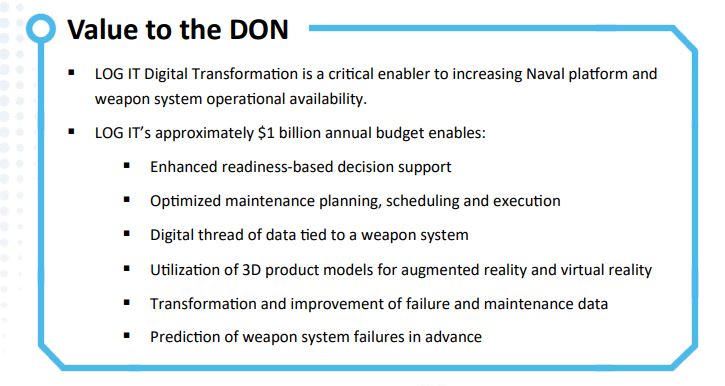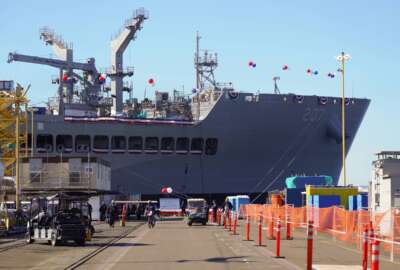Navy logistics modernization effort ready to take next step
Jeff Baur, the product director for logistics IT for the Navy’s PEO-MLB, said ensuring the new platform meets the users’ needs is a top priority.
If a sailor on a Navy ship needed to change a filter to take dust and dirt out of a system, that person would have to log in and touch as many as six different systems.
The time it took to order the part was more than just inefficient; the sailor had to use legacy IT systems that were difficult to secure.
Jeff Baur, the product director for logistics IT services in the Program Executive Office for Manpower, Logistics and Business Solutions for the Department of the Navy, said that arduous and wasteful process is about to change.
PEO-MLB is leading a logistics IT modernization effort that will modernize and make more user friendly the applications that shipyards, ships, aviation and other organizations rely on to manage parts, equipment and products across the Navy.
“We’re optimizing a commercial off the shelf (COTS) product to achieve that performance profile. The sailors are telling us how they want this tool to be configured. So we have determined that, yes, the tool can meet all of our requirements from a technical standpoint. Now it’s a matter of improving the user experience so that it’s easy for them to use,” Baur said at the AFCEA NoVa Navy IT day. “We’re applying that COTS product broadly across the Department of the Navy, against all of the user requirements that we have for shipyards, ships, aviation. And we’re implementing that solution, first starting with organizational level maintenance, but then moving on to intermediate and depot level maintenance.”
The Navy awarded a $233 million contract to IFS and Lockheed Martin in 2020 under the Naval Maintenance, Repair and Overhaul (N-MRO) program to modernize and integrate 20 separate logistics systems. Under this deal, IFS and Lockheed will provide a technology platform that seeks to combine artificial intelligence, digital twin capabilities and predictive analytics to anticipate and react to potential equipment failures before they happen. The companies said in a release from May 2021 that the technology and data will contribute to the enhanced support of maintenance, supply logistics, real-time fleet management and other business functions for more than 200,000 sailors.
Baur said PEO-MLB completed some initial testing on a ship recently and will use those results to determine the next design and capabilities for the platform.
“It’s an ongoing, deliberate process of human centered design, where we use the users as our guideline for telling us where we need to go next to improve the product’s performance,” he said. “Some users are very happy. Some users are not. For us, with the work — and this is hard work — how do we make the changes necessary to improve the system for the sailors that were dissatisfied, without taking away the goodness that we’ve already got for other groups of sailors?”
The LOG IT portfolio, which N-MRO falls under, is broken down into five core capabilities.
- Naval Product Lifecycle Management (N-PLM)
- Naval Maintenance, Repair & Overhaul (N-MRO)
- Naval Supply Chain Management (N-SCM)
- Integration and Infrastructure (I&I)
- Logistics integrated data
Through the entire portfolio, the Navy is trying to modernize more than 300 systems on land and on ships.
Baur said the N-MRO program is one of several ongoing modernization efforts.
He said the Navy also is implementing and deploying product life cycle management capability at all of its prime shipbuilders.
“We’ve employed PLM at some of our repair activities, and we intend to continue that work. We have to grow some capabilities so that we have a technical data package capability to support additive manufacturing, computer numerical control (CNC) capabilities all incorporated into PLM,” he said. “We also have to work with assistant commands to ensure that business process change is necessary for full adoption of these commercial capabilities takes place. Over in the supply world, we’re prototyping for our Naval Operational Supply System, and that’s going well. The goal is to make a decision late this year or early next year that will go back to the fleet commander and tell them what we discovered through these prototypes.”

Additionally, Baur said the LOG IT portfolio is taking advantage of the Navy’s Jupiter data analytics program.
He said PEO-MLB has added four data sets to the Jupiter platform as part of an effort to consolidate under a Logistics Integrated Data Environment. In that environment, the Navy plans to standardize and normalize the data and establish governance rules.
“All of our systems that we have today started life as transactional systems designed to support ordering of parts. What we’re doing is we’re deliberately looking at how we’re using the data outputs from those systems so that we could actually identify what data we have to collect. So it actually starts in the front end system, so we’re putting those data collection points into the front system so that we’re collecting the right data. Then what we’re doing is we’re establishing what data format has to be adhered to, to allow us to push that data into an environment where it can be used for analysis,” Baur said. “A case in point is today if I break a gizmo on a ship, I know within four hours what the warfighting impact of that will be. If it’s a material deficiency, it may take 12 hours. I know how long it’s going to take to have it repaired, based on availability of parts, availability of personnel, and then I can calculate how long that vessel is going to be degraded, so that the commander understands that and can adjust any operational plans if they have to. What we want to do is make that real time.”
Baur said the Navy isn’t so naïve to think one platform will serve everyone’s needs.
The idea is to create an enterprise platform that meets most of each organization’s needs, but then let them bolt on niche capabilities as needed.
“At the end of this journey, we’re going to have four core capabilities and logistics. We’re going to have probably several bolt-ons for niche utilization, but it’s all about making sure that user gets what he or she wants and where they do their work,” he said. “We’re going to mobile devices, and we’re doing a lot of work with PEO Digital right now. We’re calling it digital endpoints, but trying to identify the fastest way we could move information to the point of performance, so that our sailors, shipyard workers, aviation maintenance folks, have access to their systems and data. So it’s pretty exciting stuff.”
Copyright © 2025 Federal News Network. All rights reserved. This website is not intended for users located within the European Economic Area.
Jason Miller is executive editor of Federal News Network and directs news coverage on the people, policy and programs of the federal government.
Follow @jmillerWFED






